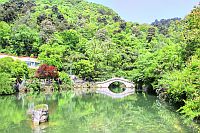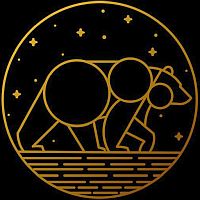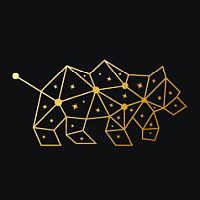Wikipedia
R.H. Allen:
Star Names
Ian Ridpath:
Star Tales
Universe Guide
Sea and Sky:
Constellations
IAU
Map
NASA:
Constellations
|
Wikipedia |
R.H. Allen: Star Names |
Ian Ridpath: Star Tales |
Universe Guide |
Sea and Sky: Constellations |
IAU Map |
NASA: Constellations |


|
|
Star LoreUrsa MajorPart 5 - Modern Day |
|


 Alaska State Flag Alaska State Flag |
Ursa Major is the most prominent constellation in the in the northern
celestial hemisphere.
 The constellation, especially the Big Dipper has inspired painters and writers and even made it onto the coat of arms of a royal family. |


| Geography |

|
|
The word Arctic comes from the Greek word ἀρκτικός (arktikos) which means
"near the Bear," derived from the word ἄρκτος (arktos), which can mean bear as well as north.
 Ian Ridpath mentions a theory by Swedish astronomy historian Peter Blomberg, stating that Blomberg believes that the word ἄρκτος was originally used meaning "north", i.e. that the constellations were in the north, and that its alternative meaning, that of a bear, was adopted later.  Sources: Wikipedia, Ian Ridpath, Peter E. Blomberg: How did the constellation of the bear receive its name? |
 Bears in the Artic
Bears in the ArticSource: polarbearsinternational.org
|


| Ed White's Star |

|
|
When NASA started the Apollo program, astronauts selected
a number of easily identifiable stars and marked them in their navigational charts.
 One of the stars picked by Astronaut Gus_Grissom, selected as commander of Apollo 1 was ι Ursae Majoris. Jokingly, Grissom named the star Dnoces, being "second" spelled backwards after his crew mate Edward H. White II.  White never had a chance to navigate by "his" star, as the crew of Apollo 1 was killed in an accident during a test just days before launch. The chart shown here was used by John Young, Command Module Pilot of Apollo 10 during NASA's second circumlunar mission.  Sources: Wikipedia |
 Dnoces in the navigational chart of Apollo 10
Dnoces in the navigational chart of Apollo 10Source: NASA |


| Art and Fiction |

|
|
Painted in September 1888, Vincent van Gogh's painting
Starry Night Over the Rhône is perhaps the most famous depiction of the
Big Dipper on canvas.
 Wikipedia tells us, that "Starry Night Over the Rhône" was one of Vincent van Gogh's paintings of Arles at night. It was painted on the bank of the Rhône that was only a one or two-minute walk from the Yellow House on the Place Lamartine, which Van Gogh was renting at the time. The night sky and the effects of light at night provided the subject for some of van Gogh's more famous paintings.  Source: Wikipedia |
 Starry Night Over the Rhône
Starry Night Over the RhôneSource: Wikipedia
|

|
|
In Strange New World, an episode of
Star Trek: Enterprise, the crew visits the (fictional) planet
Archer IV.
 The planet is described as one of the planets in orbit of 61 Ursae Majoris. It was named after the Enterprise's captain Jonathan Archer.  Sources :Wikipedia, alpha.fandom.com |
 Archer IV
Archer IVSource: alpha.fandom.com |


| Modern Day Applications |

|
|
Qixingtan (The Pond of Seven Stars), is a park in the Chinese City Guiyang.
 The park featurs seven lakes, named after the seven stars of the Big Dipper:  Tianshu Lake (α UMa), Tianxuan Lake (β UMa), Tianji Lake (γ UMa), Tianquan Lake (δ UMa) Yuhengtan ((ε UMa) Kaiyangtan (ζ UMa) and Yaoguangtan (η UMa).  Source: trip.com |
 Qixingtan Park; trip.com
Qixingtan Park; trip.com
|


|
|
In Japanese, the Big Dipper is called Hokuto Shichisei, "Seven Stars of the Northern Dipper,"
which is written 北斗七星 in both Chinese and Japanese.
 Hokuto-kun, named after the Big Dipper is the mascot of the Hokkaido Prefectural Police.  He’s a hybrid of a rabbit, an owl, a fox, a horse, and a human.  Sources: Mondo Mascots, Hokkaido Prefectural Police |
 Hokuto-kun; Mondo Mascots
Hokuto-kun; Mondo Mascots
|


|
|
In Chinese, the Big Dipper is known as Běidǒu Qīxīng, the "Seven Stars of the Northern Dipper,"
which is written 北斗七星.
 The Chinese satellite navigation system BeiDou, providing global coverage for timing and navigation, is named after the "Northern Dipper".  Source: Wikipedia |
 BeiDou Satellite Navigation System
BeiDou Satellite Navigation SystemSource: spacenews.com
|


|
|
The National Aerospace Development Administration (NADA) is
the official space agency of North Korea.
 The emblem of the NADA was instituted in 2014; according to NADA, it represents its character, mission, position and development prospects.  Also according to NADA, the Great Bear reflects the will of the space scientists of the DPRK to glorify Kim Il Sung's and Kim Jong Il's Korea as a space power.  Source: collectspace.com |
 NADA; collectspace.com
NADA; collectspace.com
|


|
|
The Big Dipper can be found in company logos all over the world. Below is a small sample, selected merely for their artistic value and NOT for the company's product. |

 Big Dipper Food
Big Dipper Food |
 CLYW Yo-Yo
CLYW Yo-Yo |

 |
 Pennsylvania Dark Sky Park
Pennsylvania Dark Sky Park
|

 Big Dipper Co. Wedding Films
Big Dipper Co. Wedding Films |
 dribbble.com
dribbble.com |
 Ursa Brewing Company
Ursa Brewing Company
|
 BrandCrowd
BrandCrowd
|


| Flags and National Symbols |

|
|
The state flag of Alaska displays eight gold stars, forming the
Big Dipper and Polaris, on a dark blue field.
The Big Dipper is an asterism in the
constellation Ursa Major which symbolizes a bear, an animal indigenous to Alaska. As depicted on the flag, its stars can be used as a guide by the
novice to locate Polaris and determine true north.
 The design was created by Benny Benson of Seward and selected from among roughly 700 entries in a 1927 contest.  Source: Wikipedia |
 Alaska State Flag; Wikipedia
Alaska State Flag; Wikipedia
|


|
|
The flag of the Community of Madrid is crimson red, with seven silver, five-pointed
stars. The stars represents each of the administrative areas of the province of Madrid.
 The stars are also thought to represent the Ursa Major and Ursa Minor constellations, in reference to the bear of the City of Madrid's coat of arms.  Source: Wikipedia |
 Community of Madrid; Wikipedia
Community of Madrid; Wikipedia
|


|
|
In 1212, the Council of Madrid used an ensign that shown a bear with the seven stars of Ursa Major or Ursa Minor. This flag was used in the
Battle of Las Navas de Tolosa.
 In 1222, the ensign was changed showing the bear, which had been displayed grazing, now standing on its hind legs, rampant, to eat fruits from a tree. Seven eight-pointed stars where shown on a bordure Azure.  Throughout the centuries, the ensign has been modified several times. The current version was adopted in 1982.  Source: Wikipedia |
 1212
1212
|
 1982
1982
|


|
|
The Big Dipper is part of the Coat of Arms of the House of Bernadotte, the royal house of Sweden.
 In Sweden, the Big dipper is known as Karlavagnen, meaning Charles's Wain, derived from the Anglo-Saxon word Churl for man.  The stars were introduced as an element in the royal coat of arms in the 19th century, chosen as a symbol of Sweden's eternal existence, as in the poem by Esaias Tegnér:  As long as Charles's Wain still turns, Its golden wheels around the Northern zone, As long as the land still produces iron and heroes, Intact shall stand the ancient Swedish throne.  Source: Wikipedia |
 House of Bernadotte
House of BernadotteWikipedia |


 |
Back to North America | Forward to Ursa Major Myth Start Page |
 |


|
Back to Star Lore |
Back to Mythology |

Back to Ursa Major |
Back to Space Page |
Back to English |
 Back to Start Page |